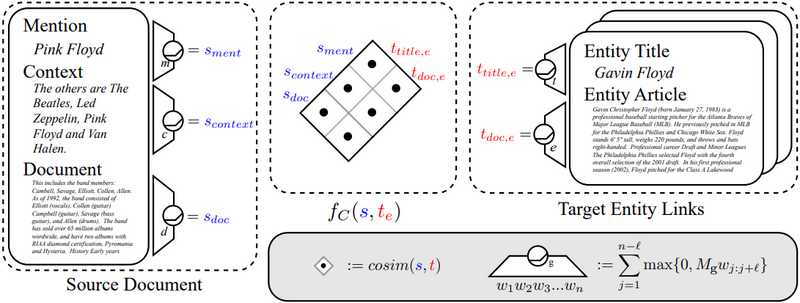2016 CapturingSemanticSimilarityforE
- (Francis-Landau et al., 2016) ⇒ Matthew Francis-Landau, Greg Durrett, and Dan Klein. (2016). “Capturing Semantic Similarity for Entity Linking with Convolutional Neural Networks.” In: Proceedings of the 2016 Conference of the North American Chapter of the Association for Computational Linguistics: Human Language Technologies (NAACL-HLT 2016).
Subject Headings: Semantic Similarity Neural Network; Entity Linking System; Convolutional Neural Network; Semantic Similarity Measure, CNN-SNN Entity Linking System.
Notes
- Online Resource(s):
Cited By
- Google Scholar: ~ 144+ Citations.
Quotes
Abstract
A key challenge in entity linking is making effective use of contextual information to disambiguate mentions that might refer to different entities in different contexts. We present a model that uses convolutional neural networks to capture semantic correspondence between a mention's context and a proposed target entity. These convolutional networks operate at multiple granularities to exploit various kinds of topic information, and their rich parameterization gives them the capacity to learn which n-grams characterize different topics. We combine these networks with a sparse linear model to achieve state-of-the-art performance on multiple entity linking datasets, outperforming the prior systems of Durrett and Klein (2014) and Nguyen et al. (2014).
1. Introduction
2. Model
Our model focuses on two core ideas: first, that topic semantics at different granularities in a document are helpful in determining the genres of entities for entity linking, and second, that CNNs can distill a block of text into a meaningful topic vector.
Our entity linking model is a log-linear model that places distributions over target entities $t$ given a mention $x$ and its containing source document. For now, we take $P \left(t|x\right) \propto \exp w^{\top}f_C \left(x, t; \theta\right)$, where $f_C$ produces a vector of features based on CNNs with parameters $\theta$ as discussed in Section 2.1. Section 2.2 describes how we combine this simple model with a full-fledged entity linking system. As shown in the middle of Figure 1, each feature in $f_C$ is a cosine similarity between a topic vector associated with the source document and a topic vector associated with the target entity. These vectors are computed by distinct CNNs operating over different subsets of relevant text.

|
(...)
3. Experimental Result
4. Conclusion
Acknowledgments
This work was partially supported by NSF Grant CNS-1237265 and a Google Faculty Research Award. Thanks to the anonymous reviewers for their helpful comments.
References
BibTeX
@inproceedings{2016_CapturingSemanticSimilarityforE,
author = {Matthew Francis-Landau and
Greg Durrett and
Dan Klein},
editor = {Kevin Knight and
Ani Nenkova and
Owen Rambow},
title = {{Capturing Semantic Similarity for Entity Linking with Convolutional
Neural Networks},
booktitle = {Proceedings of the 2016 Conference of the North American Chapter
of the Association for Computational Linguistics: Human Language Technologies
(NAACL-HLT 2016)},
pages = {1256--1261},
publisher = {The Association for Computational Linguistics},
year = {2016},
url = {https://doi.org/10.18653/v1/n16-1150},
doi = {10.18653/v1/n16-1150},
}
| Author | volume | Date Value | title | type | journal | titleUrl | doi | note | year | |
|---|---|---|---|---|---|---|---|---|---|---|
| 2016 CapturingSemanticSimilarityforE | Dan Klein Greg Durrett Matthew Francis-Landau | Capturing Semantic Similarity for Entity Linking with Convolutional Neural Networks | 2016 |